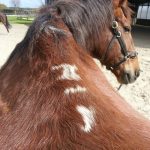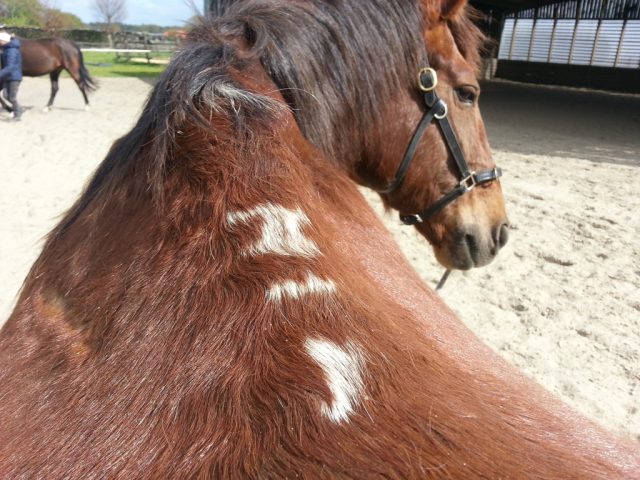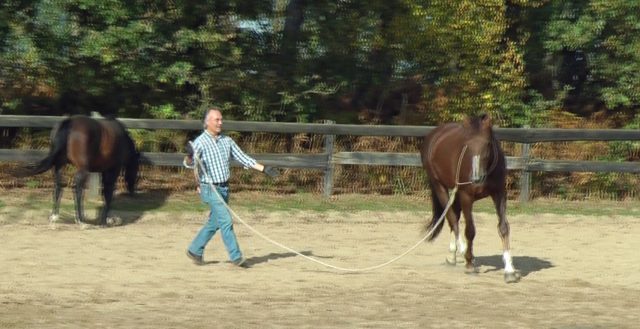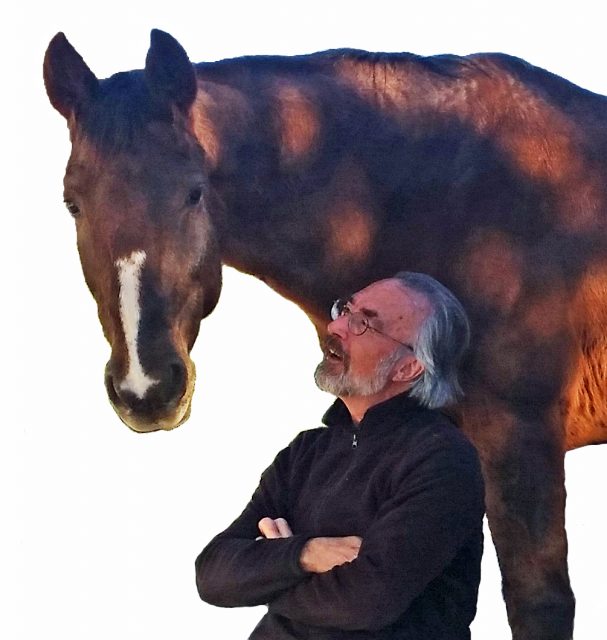 ‘Yes, but he has his ears forward, so it can’t be too bad.’ You may have heard this or something similar mentioned to justify the involvement of a horse in some or other activity. And true, the horse may have their ears forward. Yet horses may also hold their ears forward when they flee either physically or psychologically. My Pip used to be a great one for the latter. If you wanted her to trot around in circles, she would. Faster? Fine. No matter that her saddle dug into her right shoulder at one end and extended over her lumbar region at the other. She would put her ears forward and simply escape from the pain and discomfort by withdrawing into herself and travelling on autopilot.
‘Yes, but he has his ears forward, so it can’t be too bad.’ You may have heard this or something similar mentioned to justify the involvement of a horse in some or other activity. And true, the horse may have their ears forward. Yet horses may also hold their ears forward when they flee either physically or psychologically. My Pip used to be a great one for the latter. If you wanted her to trot around in circles, she would. Faster? Fine. No matter that her saddle dug into her right shoulder at one end and extended over her lumbar region at the other. She would put her ears forward and simply escape from the pain and discomfort by withdrawing into herself and travelling on autopilot.
The willing victim syndrome
This experience with Pip is also what I refer to as the willing victim syndrome. Take a sect, for instance. The members of a sect, more often than not women, place themselves at the mercy of its leader, all too often a man, in that they surrender personal control to the latter to some or other extent. There is a potential for abuse, which frequently materialises. The sect leader attempts to excuse their abuse by claiming that the victim allowed it to happen and that it is therefore not abuse. In some cases the victim may acknowledge this and blame themself.
Should this be the end of it? Absolutely not! This line of reasoning is premised on the assumption that someone else should be held accountable for the sect leader’s failure to accept responsibility for their own actions, namely, their refusal to live up to the trust which their victim has placed in them. And instead of accepting their responsibility in this respect, they lay the blame for their failure to do so on the very person who suffers as a result of their refusal to live up to the latter’s trust.
Ultimately, all of us are responsible for our own acts and omissions independently of anyone else, so too a sect leader. In the absence of any condition or circumstance which can excuse such responsibility, we may safely assume that a sect leader is aware that certain acts or omissions on their part would amount to abuse irrespective of whether or not their victim acquiesced in them, and that they are capable of refraining from such abuse. After all, acquiescence is not the same as conscious, considered consent.
Grossly dysfunctional relationships
So what does this have to do with horses? The willing victim syndrome normally (actually it is abnormal) occurs in grossly dysfunctional relationships of inequality where the party with more power knowingly abuses the other, weaker party. I have mentioned the relationship between a sect leader and a member as an example. A similar type of relationship may be found between a rock music celebrity (more often than not male) and a groupie (usually female). The violently dysfunctional relationship between an aggressive husband and a battered wife is another example, albeit an extreme one.

The illusion of liberty with a whip and a rope in a small square arena. Is Pip not a willing victim?
And so too is the relationship between a human who abuses a horse and the horse that they abuse. The use of horses for racing from the tender age of two or three, when their bones are far from formed and they are consequently vulnerable to severe physical harm in addition to the mental and emotional stress to which they are subjected may be viewed as a viciously vivid example of such a grossly dysfunctional relationship.
Unwitting misuse
Yet such an unequal relationship between horse and human can also occur at what might seem to be a more mundane and seemingly innocent level. I recall reading an interview with a very famous dressage rider who claimed that her horse did not like to be turned out all day but actually preferred to return to the stable in the middle of the day. Intrigued by such utterly uncharacteristic behaviour on the part of a horse, I continued reading in the hope of stumbling upon an explanation. Lo and behold, there was one. Not too far further on in the same interview I learned the reason for this anomaly. Apparently, the horse got fed in their stable at the same time each day. When? In the middle of the day. Small wonder that the horse wanted to cut short their turnout at that time of the day to return to their stable. As such, the horse was a willing victim of their owner’s decision to curtail their freedom every single day of their life. This is but one small example of a horse acting as a willing victim in the service of a human who wittingly abuses or unwittingly misuses them. Countless more, many with more horrendous consequences for the horse, occur every single day. But because the horse is a willing victim in cases such as this, we often fail to see most of them.
In the absence of any knowledge of such concern and commitment on the part of their human, the horse simply experiences their use by humans as an exercise in control, domination and/or hostility, and they respond accordingly, more often than not simply tolerating what occurs while displaying signs of pain, anxiety or fear. Sadly, research indicates that a very significant majority of ‘horse people’, even professionals, cannot recognise such signs and are more likely than not to involve their own horses in activities which give rise to pain, anxiety or fear in those sensitive animals. In such a situation, the horse is a willing victim while being unwittingly misused rather than wittingly abused. Of course, such a distinction is effectively academic to horses. As they experience them, the effects are identical, differing only in degree.
The call of the horse
Pressed hard enough, horses are survivors and in order to survive, they need to mask weakness one way or another. Let us not be fooled by one small body part and what we think that it may be communicating. Rather, let us view the entire horse and above all feel the energy in the moment. It is only then that we will truly have some sense of what the horse is feeling.
Do those of us humans who keep, use or train horses not have a duty to do all that we reasonably can to understand the intrinsic nature of the horse, so as to be able to recognise when they are in physical, mental or emotional pain or discomfort with a view to alleviating it? And where our horses are willing victims of our abuse or misuse, are we not called upon to acknowledge that responsibility for our actions is not contingent on what they allow us to do to or refrain from doing for them but is entirely independent of them and ours alone? So where do we start?
(Taken from the final draft of the book, Being Humans for Horses, due to be released on 4 July 2020. Click here for more information.)
Equine Touch
Our Equine Touch business is called Humans for Horses, you can find our website at:
http://www.humansforhorses.com/
and our Facebook page at:
https://www.facebook.com/Humans.for.Horses
Horses and Humans on Facebook
May I remind you that we now have a Horses and Humans group on Facebook. If you would like to leave a comment, you can do so on this blog or on the the Horses and Humans Facebook group page. All new posts will feature on that page along with additional content posted by any of our members. Please feel free to join us at:
https://www.facebook.com/groups/horsesandhumans/
There is also a Horses and Humans publications page, which contains information concerning the publications released under the Horses and Humans imprint. Some of those publications will be free of charge. You will find it here:
https://www.facebook.com/horsesandhumans
I also have a Facebook page through which you may contact me. You will find it at:
https://www.facebook.com/andrewglynsmail





